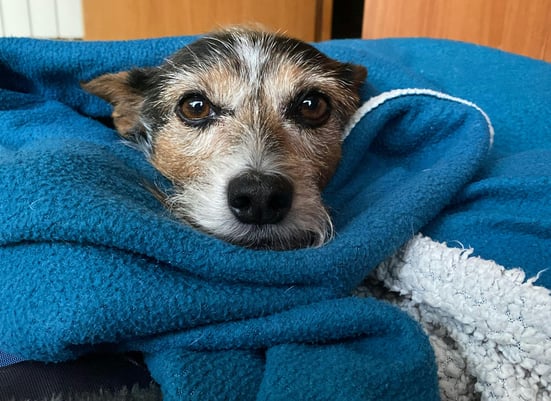How to Calm a Scared Dog? Expert Tips and Techniques
DOG BEHAVIOR AND TRAINING


Dogs can become scared for various reasons, not all of which are obvious to us. Regardless of the trigger, a scared dog will often respond by hiding, trying to escape, drooling excessively, whining, or trembling. Fear responses vary based on breed, personality, and past experiences. Some dogs recover quickly, while others may develop long-term anxiety if their fears are not managed properly.
This situation can be highly stressful for your furry friend. Therefore, knowing how to act is essential to reduce or minimize their fear. In this article, we’ll explore how to calm a scared dog at home or outdoors and provide actionable advice to keep your pet safe and comfortable.
Why is My Dog Scared and Hiding?
Dogs have heightened senses, such as hearing and smell, which makes them more sensitive to certain stimuli that may go unnoticed by humans. Understanding the root cause of your dog’s fear is the first step to addressing it. Some common triggers include:
Loud Noises – Fireworks, thunderstorms, vacuum cleaners, sirens, and loud traffic sounds can unsettle them. Noise phobia is common in many breeds, particularly herding and hunting dogs.
Unknown Elements – Bicycles, strangers, unfamiliar animals, or even new household items can frighten them.
Past Trauma – Rescue dogs or those with a history of abuse may have deep-seated fears.
Lack of Socialization – Dogs that have not been exposed to various people, places, and sounds during puppyhood may be more fearful.
Changes in Environment – Moving to a new home, new family members, or even rearranging furniture can be unsettling.
Health Issues – Pain, neurological disorders, or cognitive dysfunction syndrome (especially in older dogs) can trigger fear-like behaviors. If your dog shows signs of fear without a clear cause, consult your veterinarian.


Signs of Fear in Dogs
A fearful or anxious dog may display various physical and behavioral signs, including:
Barking or whining excessively.
Excessive drooling and panting.
Pacing or restlessness.
Hiding or attempting to escape.
Trembling or cowering.
Destructive behavior (chewing, scratching furniture).
Urinating or defecating indoors despite being house-trained.
In extreme cases, fear can lead to dangerous behaviors, such as attempting to escape by bolting, breaking free from their leash, or even jumping out of windowsaquí...
Steps to Calm a Scared Dog at Home
If your dog becomes scared at home, take action immediately to prevent their fear from escalating. Here’s how:
1. Stay Close and Calm
Be a comforting presence. Sit near your dog, speak softly, and avoid sudden movements. If your dog seeks comfort, pet them gently, but if they prefer space, respect their boundaries.
2. Create a Safe Space
Move your dog to a small, enclosed room with controlled access. Lower the lights, reduce noise, and close blinds or cover windows if necessary. Relaxing music or the sound of a TV can help mask frightening sounds.
3. Avoid Force or Yelling
Never scold, punish, or force your dog to face their fear. This will only heighten their anxiety and may make the fear worse over time.
4. Use Calming Techniques
Offer a chew toy or lick mat, as repetitive chewing and licking behaviors help release calming hormones.
Try pheromone diffusers like Adaptil to create a soothing environment.
Use gentle massage techniques to relax tense muscles.
5. Distract with Activities
If your dog’s fear is mild, engage them in play with their favorite toy or practice simple obedience commands. Reward calm behavior with treats.
6. Consider Professional Help
If your dog experiences frequent or intense fear episodes, consult a vet about safe anxiety-reducing medications or seek guidance from a professional dog trainer.tu texto aquí...
How to Calm a Scared Dog Outside
Fearful behavior outdoors is particularly concerning due to the risk of your dog escaping or injuring themselves. Follow these steps to keep your dog safe and calm:
1. Stay Composed
Dogs pick up on human emotions. If you panic, your dog’s anxiety may worsen. Remain calm and confident.
2. Secure the Leash and Collar
Always use a well-fitted harness and leash, preferably a double-clip leash system, to prevent your dog from slipping free.
3. Move Away from Triggers
Increase the distance between your dog and the source of fear (traffic, other animals, strangers). Once they calm down, reward them with treats or praise.
4. Distract with Play or Obedience
Engage your dog in a game, use their favorite toy, or guide them through basic commands to shift their focus.
5. Return Home if Necessary
If your dog is overwhelmed and cannot calm down, it’s best to end the walk and return to a safe environment....
How to Prevent Fear in Dogs
Preventing fear in your dog is often possible by addressing its root causes. Here are key strategies:
Socialization – Expose your dog to various sights, sounds, and experiences while they are young to build confidence.
Introduce Changes Gradually – Allow your dog to adjust slowly to new environments, people, or objects.
Use Secure Gear – Walk your dog with a properly fitted harness and leash to prevent accidents.
Stick to Routines – Dogs feel safe with predictable routines. Maintain regular feeding, walking, and play schedules.
Provide Physical and Mental Stimulation – A tired dog is less likely to react strongly to triggers. Ensure they get daily exercise and mental enrichment.
Create a Safe Haven – Set up a cozy, quiet area in your home where your dog can retreat when feeling overwhelmed.
Use Calming Aids – Calming collars, diffusers, and supplements can reduce stress. Use them before predictable stressors, such as fireworks or travel.
Seek Professional Help – If your dog’s fear is severe or persistent, consult a dog behaviorist for tailored strategies. aquí...
Keep Your Dog Calm and Happy
Helping your dog navigate fear is essential for their emotional well-being and safety. By understanding their triggers and taking proactive measures, you can create a supportive environment where your furry friend feels secure and loved. With patience, consistency, and the right techniques, you can help your dog overcome their fears and lead a happier, more relaxed life.


